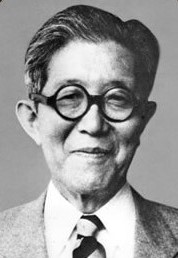Michita Sakata | |
|---|---|
坂田 道太 | |
 Sakata in 1968 | |
| Speaker of the House of Representatives | |
| In office 24 January 1985 – 2 June 1986 | |
| Monarch | Hirohito |
| Preceded by | Kenji Fukunaga |
| Succeeded by | Kenzaburō Hara |
| 40th Minister of Justice | |
| In office 30 November 1981 – 27 November 1982 | |
| Cabinet | Zenkō Suzuki Reformed Cabinet |
| Preceded by | Seisuke Okuno |
| Succeeded by | Akira Hatano |
| 33rd Director-General of the Defense Agency | |
| In office 12 September 1974 – 24 December 1976 | |
| Cabinet | Takeo Miki Cabinet Takeo Miki Reformed Cabinet |
| 91st/92nd Minister of Education | |
| In office 30 November 1968 – 5 July 1971 | |
| Cabinet | Eisaku Satō II Second Reformed Cabinet Eisaku Satō III |
| Preceded by | Hirokichi Nadao |
| Succeeded by | Saburo Takami |
| 33rd Minister of Health and Welfare | |
| In office 12 January 1959 – 18 June 1959 | |
| Preceded by | Ryogo Hashimoto |
| Succeeded by | Yoshio Watanabe |
| Member of the House of Representatives | |
| In office 11 April 1946 – 24 January 1990 | |
| Constituency | Kumamoto (now Kumamoto 2nd district) |
| Personal details | |
| Born | 18 July 1916 Yatsushiro, Kumamoto Prefecture, Japan |
| Died | 13 January 2004 (aged 87) |
| Political party | Democratic Liberal Liberal (1945) Liberal (1950) Liberal Democratic |
| Parent |
|
| Alma mater | Tokyo Imperial University Faculty of Letters |
| Awards | Junior Second Rank Order of the Paulownia Flowers |
Michita Sakata (Japanese: 坂田 道太; 18 July 1916 – 13 January 2004) was a Japanese politician and member of the House of Representatives of Japan. Throughout his career, he served as the Minister of Education, Head of the Defense Agency, Minister of Justice, Minister of Health and Welfare, and Speaker of the House of Representatives.[1]
Sakata's prolific career spanned over 40 years, beginning in 1946 and ending in his retirement in 1990, being reelected 16 times to the House of Representatives. He is most known for his role in the suppression of the 1968-69 Japanese university protests as Minister of Education,[2] as well as for his tenure as the Director of the Defense Agency, when he helped write the National Defense Program Outline and set guidelines for US-Japan cooperation.
- ^ Masamori 2017, p. vii.
- ^ Masamori 2017, p. xv–xvi.
© MMXXIII Rich X Search. We shall prevail. All rights reserved. Rich X Search
